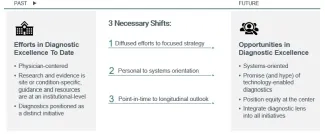Summary
- Advancing diagnostic excellence is a crucial endeavor that requires a multifaceted approach. By learning from the past, embracing future opportunities, and shifting our approach, we can significantly improve diagnostic accuracy and timeliness.
In the constantly evolving landscape of health care, improving diagnostic accuracy and timeliness remains a critical challenge. As we strive for diagnostic excellence, it's essential to learn from historical approaches while embracing new opportunities. Let's explore how we can move forward in this crucial area of health care, considering both the lessons of the past and the promising avenues of the future.
Learning from the Past
Historically, efforts to improve diagnostics have faced several challenges that have hindered progress and highlighted the need for more integrated and collaborative strategies:
- Physician-centric focus: Initiatives often centered on individual clinician performance, overlooking the importance of team-based approaches and active inclusion of the patient in the diagnostic process. This narrow perspective failed to recognize the complex, interconnected nature of the diagnostic process.
- Limited research scope: Studies frequently focused on specific conditions or settings, limiting the applicability of findings across diverse health care environments. This site and condition-specific research created a disconnect between research findings and practical applications in various clinical settings.
- Siloed initiatives: Diagnostic improvement efforts were often isolated within particular service lines or populations, missing opportunities for cross-disciplinary learning and execution. This approach led to redundancies and missed chances for broader health care improvements.
Embracing Future Opportunities
To advance diagnostic excellence, we must seize emerging opportunities that promise more patient-centered, technologically advanced, and equitable approaches to care delivery:
- Systems-oriented approach: Viewing diagnosis as a longitudinal experience that begins when patients first recognize symptoms can enhance accuracy and timeliness. This perspective acknowledges multiple opportunities for disease identification and intervention throughout the patient journey.
- Technology-enabled diagnostics: Artificial intelligence (AI) shows promise in fields like radiology and pathology, though careful validation is necessary. AI has demonstrated potential in improving image analysis and pattern recognition, but evidence supporting widespread adoption is still developing.
- Equity-centered initiatives: Addressing disparities in diagnostic errors among minority populations is crucial for improving overall health care quality. Studies have shown that racial and ethnic minorities experience higher rates of misdiagnosis and delayed diagnosis, making it essential to embed equity into diagnostic initiatives.
- Integrated improvement efforts: Recognizing the diagnostic component in every condition and population can inform broader applications of diagnostic excellence. This approach allows for testing and learning that can be applied more widely across health care systems.

Making the Shift
To realize these opportunities and advance diagnostic excellence, three critical shifts are necessary:
- Develop a cohesive strategy: Align goals across organizations and foster collaboration among stakeholders. This shift involves transitioning from a collection of diffused initiatives to a focused, unified approach that brings together various health care entities.
- Embrace a systemic orientation: Move from blaming individuals to understanding systemic factors in diagnostic errors. This cultural shift is crucial for addressing the stigma and fear of litigation associated with diagnostic errors. Encouraging open dialogue about errors can promote learning and improvement.
- Adopt a longitudinal perspective: Recognize diagnosis as an ongoing process with multiple intervention opportunities. This shift acknowledges that diagnosis is not a point-in-time event but a continuum that begins when patients first recognize symptoms and continues throughout their health care journey.
Advancing diagnostic excellence is a complex but crucial endeavor that requires a multifaceted approach. By learning from past challenges, embracing future opportunities, and making necessary shifts in our approach, we can significantly improve diagnostic accuracy and timeliness. This journey requires fostering a culture of continuous learning, collaboration, and patient-centeredness.
Bhargavi Sampath is a DrPH Student and Bloomberg Fellow at Johns Hopkins University. Kate Feske-Kirby is an IHI Research Associate, Innovation. Keziah Imbeah is an IHI Senior Research Associate, Innovation.
Photo by Hadija on Unsplash
You might also be interested in:
